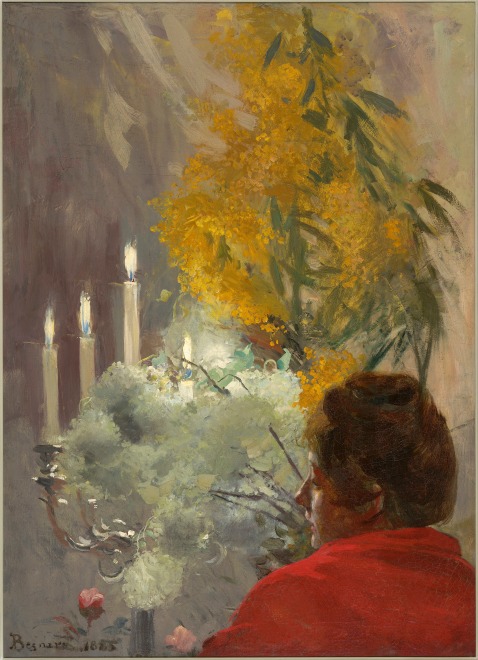Provenance
Private collection, FranceExhibited
Paris, Galerie Petit, Exposition internationale de peinture et de sculpture, 1885, as A la lueur des bougies
Paris, Salon de la Société Nationale des Beaux-Arts, 1890, as À la lueur des bougies, no.66
Venice, Esposizione Internazionale d’arte della citta di Venezia, 1905 as Al lume di candela, no.3, p. 50
Paris, Château de Bagatelle, Exposition de la Société nationale des beaux-arts, 1906, no. 20 as Une femme
Literature
Théodore Véron, Dictionnaire Véron, ou mémorial de l’art et des artistes de mon temps, Poitiers, Bazin, 1885, p. 692
Léopold Mabilleau, “Le Salon du Champ de Mars,“ Gazette des beaux-arts, Vol. 3, 1 July 1890, p.23
A Ferney, “Au champ de Mars,“ Journal des artistes, no. 21, 1 June 1890, p. 1
L. de Fourcaud, “Exposition de la société nationale des beaux-arts,“ Salon Illustré, 1 September 1890, p.4
“L’exposition de Bagatelle,“ The New York Herald, May 1906, p. 5
Ns, “A travers Paris“, Le Figaro, 8 May 1906, p. 1
José Belon, “Au château de Bagatelle,“ La Presse, 12 May 1906, p. 1
Chantal Beauvalot, “L’image de la femme dans l’œuvre d’Albert Besnard, ou la sensation extrême de la vie,“ in Albert Besnard (1849-1934), Modernités Belle-Époque, Paris, Somogy, 2016, fig. 9, p. 39
Catalogue note
In this extraordinary “portrait” Besnard has depicted Madeleine Lerolle, née Escudier (1856-1937), the wife of his good friend - the painter, collector and patron, Henry Lerolle. Henry Lerolle’s most well-known work was The Organ Rehearsal, which featured Madeleine as the seated figure in the foreground (The Metropolitan Museum of Art, New York), however, he was more consequential as a patron of the arts; his collection included works by Maurice Denis, Puvis de Chavannes, Bonnard, Degas and Renoir. These artists, together with Besnard and the composers Debussy and Ernest Chausson and the writers Stéphane Mallarmé, Paul Valéry and André Gide, were often guests at the regular Salons hosted by the Lerolles at their opulent Paris residence located on 20 Avenue Duquesne. Possibly our painting was commissioned by Lerolle to commemorate one of these festive get-togethers.
Recognized for her extreme beauty, Madeleine Lerolle was the subject of Fantin Latour’s 1882 Salon entry (The Cleveland Museum of Art). She was also painted by Besnard shown with her young daughter, Yvonne in an earlier painting from 1883 (The Cleveland Museum of Art). While these paintings of Madame Lerolle were both examples of traditional portraiture, our painting evokes a much different sentiment and therefore, interpretation.
Titled À la lueur des Bougies or By Candlelight, this image does not conform to the conventional norms of portraiture. The presence of Madame Lerolle seems only a pretext in the development of the subject. The space occupied by the sitter (which almost appears as an apparition; we cannot see if she is seated or standing) is totally abstract with no hint of a third dimension. The muted grey background is layered with floral motifs – a bouquet of “boules de neige” and bright yellow mimosas streaked with spears of dark green foliage. Besnard used a similar floral motif in his Portrait of Madame Roger Jourdain from the Salon of 1886 (Musée des Art Décoratifs, Paris). Besnard often resorted to the “fantasy” of depicting his models shown from behind with their face in profile. Here, this idea is emphasized by the bright red “triangle” of Madame Lerolle’s shawl, which covers her shoulders and becomes a focal point of the composition. We know from the title, By Candlelight that the soft light reflected on Madame Lerolle’s face is coming from a candelabra, the brightness of the candle flames diffused through the flowers. It was very characteristic of Besnard to use different light sources in his paintings: natural, such as the setting sun or candle light, or artificial as seen in the street lamps, which were starting to illuminate the grand boulevards of Paris. The years between 1880 and 1890 saw the first electricity appearing in affluent Paris homes, especially those in the new Haussmann districts.
Although the product of rigorous training at the École des Beaux-Arts, Besnard was still able to transcend the rules of a rigid academic education and reach a new modernity that crowned him a legitimate heir of Edouard Manet. Manet’s early death at age 51 left a void to maintain and continue the style that could be called “classic modernity.” Albert Besnard lived on until the second third of the 20th century, and had a fruitful career occupied in large part by numerous successful and influential decorative projects.

